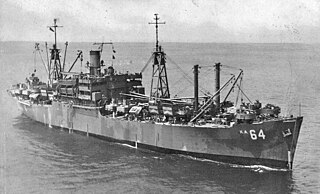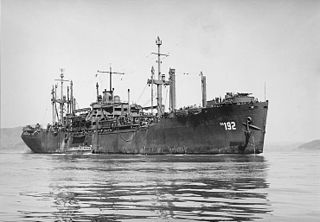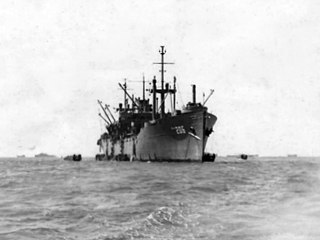
USS Barber (DE-161/APD-57) was a Buckley-class destroyer escort in service with the United States Navy from 1943 to 1946. In 1969, she was sold to Mexico where she served until 2001.

USS Torrance (AKA-76) was a Tolland-class attack cargo ship of the United States Navy named after Torrance County, New Mexico. She was designed to carry military cargo and landing craft, and to use the latter to land weapons, supplies, and Marines on enemy shores during amphibious operations. She served as a commissioned ship for 19 months.

USS Arenac (APA-128) was a Haskell-class attack transport in service with the United States Navy from 1945 to 1946. She was scrapped in 1974.

USS St. Mary's (APA-126) was a Haskell-class attack transport in service with the United States Navy from 1944 to 1946. She was scrapped in 1975.

USS Hinsdale (APA-120) was a Haskell-class attack transport ins service with the United States Navy from 1944 to 1946. She was scrapped in 1974.

USS La Grange (APA-124) was a Haskell-class attack transport in service with the United States Navy from 1944 to 1945. She was scrapped in 1975.

USS Rutland (APA-192) was a Haskell-class attack transport built and used by the US Navy in World War II. She was a Victory ship design, VC2-S-AP5. She was named after Rutland County, Vermont, USA.

USS Pinkney (APH-2) was a Tryon-class evacuation transport that was assigned to the U.S. Navy during World War II. Pinkney served in the Pacific Ocean theatre of operations and returned home safely post-war with six battle stars but missing 18 crew members who were killed in action.

USS Logan (APA-196) was a Haskell-class attack transport of the United States Navy, named for counties in Colorado, Illinois, Kansas, Kentucky, Ohio, Oklahoma, Nebraska, North Dakota, and West Virginia. The Haskell-class design, United States Maritime Commission standard type VC2-S-AP5, is a sub type of the World War II Victory ship design.

USS Impeccable (AM-320) was an Auk-class minesweeper built for the United States Navy during World War II. She was originally ordered as HMS Brutus (BAM-7) for the United Kingdom's Royal Navy under Lend-Lease, but was acquired and renamed by the United States Navy before construction began. She was commissioned in 1944 and served in the Pacific before being decommissioned in 1947. After the outbreak of hostilities in Korea, Impeccable was recommissioned in 1952 and served off Korea through 1952. She was decommissioned for the final time in October 1955 and placed in reserve. She was sold for scrapping in 1974.

USS Neshoba was a Haskell-class attack transport in service with the United States Navy from 1944 to 1946. She was scrapped in 1975.

USS Sabik (AK-121) was a Crater-class cargo ship commissioned by the U.S. Navy for service in World War II. She was responsible for delivering troops, goods and equipment to locations in the war zone.

USS Beckham (APA-133) was a Haskell-class attack transport in service with the United States Navy from 1944 to 1946. She was scrapped in 1974.
USS McCracken (APA-198) was a Haskell-class attack transport acquired by the U.S. Navy during World War II for the task of transporting troops to and from combat areas.

USS Clay (APA-39) was a Bayfield class attack transport in service with the United States Navy from 1943 to 1946. She was then sold into commercial service and was scrapped in 1974.

USS Meriwether (APA-203) was a Haskell-class attack transport that saw service with the US Army in World War II.

USS Sibley (APA-206) was a Haskell-class attack transport in service with the United States Navy from 1944 to 1946. She was scrapped in 1975.

USS Natrona (APA-214) was a Haskell-class attack transport of the US Navy in World War II. She was of the VC2-S-AP5 Victory ship design type. Natrona was named for Natrona County, Wyoming.

USS Charles Carroll (APA-28) was a Crescent City-class attack transport that served with the US Navy during World War II.

USS Pavlic (APD-70) was built by Dravo Corporation at Pittsburgh, Pennsylvania as a Buckley-class destroyer escort. Pavlic was launched 18 December 1943 and towed to Texas for refitting as a United States Navy high-speed transport. Pavlic was in commission from 1944 to 1946, serving in the Okinawa campaign as a radar picket ship. Pavlic was decommissioned 15 November 1946. After more than 20 years of inactivity in reserve, she was stricken from the Navy List on 1 April 1967. On 1 July 1968, she was sold for scrapping to North American Smelting Company.
USS Berrien 'News of the Day' paper. 15 Dec. 1945
USS Berrien Navy Day paper, 27 Oct. 1945



















